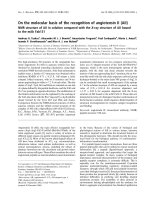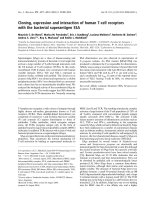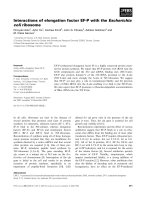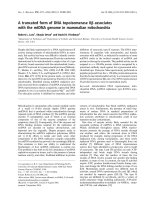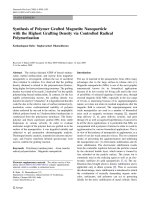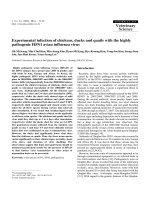ACTUARIAL STANDARD OF PRACTICE NO 24 COMPLIANCE WITH THE NAIC LIFE INSURANCE ILLUSTRATIONS MODEL REGULATION
Bạn đang xem bản rút gọn của tài liệu. Xem và tải ngay bản đầy đủ của tài liệu tại đây (81.29 KB, 21 trang )
Actuarial Standard
of Practice
No. 24
Compliance with the
NAIC Life Insurance Illustrations
Model Regulation
Revised Edition
Developed by the
Task Force to Revise ASOP No. 24 of the
Life Committee of the
Actuarial Standards Board
Adopted by the
Actuarial Standards Board
February 2007
Updated for Deviation Language Effective May 1, 2011
(Doc. No. 142)
ASOP No. 24—February 2007
TABLE OF CONTENTS
Transmittal Memorandum iv
STANDARD OF PRACTICE
Section 1. Purpose, Scope, Cross References, and Effective Date 1
1.1 Purpose 1
1.2 Scope 1
1.3 Cross References 1
1.4 Effective Date 2
Section 2. Definitions 2
2.1 Actual Experience 2
2.2 Current Payable Scale 2
2.3 Disciplined Current Scale 2
2.4 Experience Factor Class 2
2.5 Experience Factor 2
2.6 Illustrated Scale 2
2.7 Illustration Actuary 2
2.8 Nonguaranteed Element 2
2.9 Nonguaranteed Element Framework 2
Section 3. Analysis of Issues and Recommended Practices 3
3.1 Regulatory Requirements 3
3.2 Appointment as Illustration Actuary 3
3.3 Illustrated Scale Requirement 3
3.4 Disciplined Current Scale 3
3.4.1 Assumptions Underlying the Disciplined Current Scale 3
3.4.2 Relationship of Actual Experience to Disciplined Current Scale 6
3.5 Requirements for Self-Support 7
3.6 Requirements to Prevent Lapse-Supported Illustrations 7
3.7 Illustrations on Policies In Force One Year or More 8
3.8 Changes in Practice 9
3.9 Reliance on Data or Other Information Supplied by Others 9
3.10 Documentation 9
Section 4. Communications and Disclosures 10
4.1 Notice of Error in Certification 10
4.2 Disclosures 10
APPENDIXES
Appendix 1Background and Current Practices 12
Background 12
Current Practices 12
ii
ASOP No. 24—February 2007
Appendix 2—Comments on the Exposure Draft and Responses 14
iii
TO: ASOP No. 24—February 2007
FROM: February 2007
SUBJ: Members of Actuarial Organizations Governed by the Standards of Practice of the
Actuarial Standards Board and Other Persons Interested in Compliance with the
NAIC Life Insurance Illustrations Model Regulation
Actuarial Standards Board (ASB)
Actuarial Standard of Practice (ASOP) No. 24
This document contains the final version of the revision of ASOP No. 24, Compliance with the
NAIC Life Insurance Illustrations Model Regulation.
Background
The ASB adopted ASOP No. 24, Compliance with the NAIC Life Illustrations Model Regulation
(hereafter Model), in 1995. Since the promulgation of the original standard, product innovation
has continued. The Task Force to Revise ASOP No. 24 of the Life Committee of the ASB
prepared this revision of ASOP No. 24 to be consistent with the current ASOP format and to
update and reflect current, generally accepted actuarial practices with respect to illustrations
prepared in compliance with the Model.
Exposure Draft
The exposure draft of this revision was issued in April 2006 with a comment deadline of August
1, 2006. The Task Force to Revise ASOP No. 24 carefully considered the seven comment letters
received and made changes to the language in several sections in response. For a summary of the
substantive issues contained in the exposure draft comment letters and the responses, please see
appendix 2.
There were no significant changes from the exposure draft.
The ASB voted in February 2007 to adopt this standard.
iv
ASOP No. 24—February 2007
Task Force to Revise ASOP No. 24
Michael A. Cioffi, Chairperson
Jose Andrade-Cora Dale S. Hagstrom
Jess S. Geller Gary E. Wheeler
Life Committee of the ASB
Charles Carroll, Chairperson
Jeremy J. Brown Esther H. Milnes
Michael A. Cioffi David Y. Rogers
Dale S. Hagstrom
Actuarial Standards Board
Cecil D. Bykerk, Chairperson
Albert J. Beer David R. Kass
William C. Cutlip Godfrey Perrott
Alan D. Ford Lawrence J. Sher
Robert G. Meilander Karen F. Terry
v
ASOP No. 24—February 2007
ACTUARIAL STANDARD OF PRACTICE NO. 24
COMPLIANCE WITH THE
NAIC LIFE INSURANCE ILLUSTRATIONS
MODEL REGULATION
STANDARD OF PRACTICE
Section 1. Purpose, Scope, Cross References, and Effective Date
1.1 Purpose—This actuarial standard of practice (ASOP) provides guidance to actuaries when
performing professional services pursuant to an applicable law based on the Life
Insurance Illustrations Model Regulation (hereafter the Model) adopted by the National
Association of Insurance Commissioners (NAIC) in December 1995 or when performing
professional services with respect to illustrations represented to be in accordance with the
Model.
1.2 Scope—This standard applies to actuaries when performing professional services pursuant
to an applicable law based on the Model. The Model applies to illustrations, both for
proposals and in-force policies, as described in the Model, for group and individual life
insurance other than variable life insurance. The Model does not apply to individual and
group annuity contracts, credit life insurance, and life insurance policies with no
illustrated death benefits on any individual exceeding $10,000.
This standard applies to actuaries when performing professional services with respect to
illustrations in the absence of applicable regulations if the illustrations are to be
represented as being in accordance with the Model.
This standard does not apply to actuaries when performing professional services with
respect to the determination of nonguaranteed elements payable. Determination of these
items, as well as illustrations not included in the scope of this ASOP, are covered by
ASOP No. 2, Nonguaranteed Charges or Benefits for Life Insurance Policies and Annuity
Contracts, or ASOP No. 15, Dividends for Individual Participating Life Insurance,
Annuities, and Disability Insurance.
If the actuary departs from the guidance set forth in this standard in order to comply with
applicable law (statutes, regulations, and other legally binding authority), or for any other
reason the actuary deems appropriate, the actuary should refer to section 4.
1.3 Cross References—When this standard refers to the provisions of other documents, the
reference includes the referenced documents as they may be amended or restated in the
future, and any successor to them, by whatever name called. If any amended or restated
1
ASOP No. 24—February 2007
document differs materially from the originally referenced document, the actuary should
consider the guidance in this standard to the extent it is applicable and appropriate.
1.4 Effective Date—This standard is effective for actuarial services performed on or after
June 30, 2007.
Section 2. Definitions
The terms below are defined for use in this actuarial standard of practice. Definitions 2.2, 2.3, 2.6,
2.7, and 2.8 are intended to conform to those in the Model.
2.1 Actual Experience—Historical results and trends in those results.
2.2 Currently Payable Scale—A scale of nonguaranteed elements in effect for a policy form as
of the preparation date of the illustration or declared to become effective within the next
95 days.
2.3 Disciplined Current Scale—A scale of nonguaranteed elements, certified annually by the
illustration actuary, constituting a limit on illustrations currently being illustrated by an
insurer that is reasonably based on actual recent historical experience and that satisfies the
requirements set forth in the Model.
2.4 Experience Factor Class—A group of policies for which nonguaranteed elements are
determined by using common numerical values of a particular experience factor.
2.5 Experience Factor—A value or set of values that represents the actual experience of a
policy form. Examples of experience factors include rates of mortality, expense,
investment income, termination, and taxes.
2.6 Illustrated Scale—A scale of nonguaranteed elements currently being illustrated that is not
more favorable to the policyholder than the lesser of the disciplined current scale or the
currently payable scale.
2.7 Illustration Actuary—An actuary who is appointed in accordance with the requirements
set forth in the Model.
2.8 Nonguaranteed Element—Any element within an insurance policy that affects policy costs
or values that is not guaranteed or not determined at issue. A nonguaranteed element may
provide a more favorable value to the policyholder than that guaranteed at the time of
issue of the policy. Examples of nonguaranteed elements include policy dividends, excess
interest, mortality charges, expense charges, indeterminate premiums, and participation
rates and maximum rates of return for indexed life insurance products.
2.9 Nonguaranteed Element Framework—The structure by which the insurer determines
nonguaranteed elements. This includes the assignment of policies to experience factor
2
ASOP No. 24—February 2007
classes, the method of allocating income and costs, and the structure of the formulas or
other methods of using experience factors. For participating policies this would be the
dividend framework defined in ASOP No. 15. For life policies within the scope of ASOP
No. 1, the nonguaranteed element framework would include the concepts of policy class,
determination policy, and anticipated experience factors.
Section 3. Analysis of Issues and Recommended Practices
3.1 Regulatory Requirements—The Model contains detailed instructions, technical
requirements, and prohibitions regarding many aspects of illustrations. Actuaries
providing professional services within the scope of this standard should be familiar with
the Model, any applicable state law based on the Model, including state variations, and this
standard.
3.2 Appointment as Illustration Actuary—Before accepting an appointment as an illustration
actuary, the actuary should determine that he or she meets the qualifications described in
the qualification standards of the American Academy of Actuaries. The appointment
should be in writing and should describe the scope of the illustration actuary’s
responsibilities and establish the effective date. Acceptance of or withdrawal from the
position should also be in writing.
3.3 Illustrated Scale Requirement—The Model requires that the illustrated scale must not be
more favorable to the policyholder than the currently payable scale at any duration. In
addition, the illustrated scale must be no more favorable to the policyholder than the
disciplined current scale at any duration.
3.4 Disciplined Current Scale—The actuary should consider the following when developing
the disciplined current scale:
3.4.1 Assumptions Underlying the Disciplined Current Scale—The actuary should use
experience as analyzed within the insurer’s nonguaranteed element framework
when setting experience factors underlying the disciplined current scale. To the
extent actual experience is determinable, available, and credible, the actuary
should use actual experience when setting experience factors underlying the
disciplined current scale. When such suitable data are lacking, experience factors
should be derived in a reasonable and appropriate manner from actual experience
of other similar classes of business. Similar classes may be found within the same
company, may be found in other companies, or may be from other sources, in that
order of preference. As required by the Model, the experience factors underlying
the disciplined current scale may not include any projected trends of improvement
nor any assumed improvements in experience beyond the effective date of the
illustrated scale, except as provided in section 3.8.
The actuary should consider the following when setting assumptions:
3
ASOP No. 24—February 2007
a. Investment Return—The investment return factors underlying the
disciplined current scale should be reasonably based on recent actual
investment experience, net of default costs, of the assets supporting the
policy block. For an indexed life insurance product where the investment
assumption is sensitive to business or economic cycles, the actuary should
consider an appropriate time frame commensurate with such cycles and the
characteristics of the underlying index in determining recent actual
experience.
The actuary should have a reasonable basis for allocating investment
income to policies, whether using the portfolio, segmentation, investment
generation, or any other method. The actuary should develop the
investment return factors using the same method that is used to allocate
investment income to policies. The investment return factors may be net of
investment expenses or, alternatively, investment expenses may be treated
separately as expenses.
The actuary should use procedures that have a reasonable theoretical basis
for determining the investment return factors. In determining the
investment return factors, the actuary should reflect the insurer’s actual
practice for nonguaranteed elements with respect to realized and unrealized
capital gains and losses, investment hedges, policy loans, and other
investment items.
b. Mortality—The actuary should base the mortality experience factors on the
insurer’s mortality experience, if credible, adjusted for risk class. In setting
mortality experience factors, the actuary should consider credible variations
by age, gender, duration, marketing method, plan, size of policy, policy
provisions, risk class, and other items (or a combination thereof) consistent
with the insurer’s structure of mortality experience factor classes. To the
extent that the insurer’s actual experience is not sufficiently credible, the
actuary should consider using other credible industry mortality experience,
appropriately modified to reflect the insurer’s underwriting practices. If no
credible industry mortality experience is available, the actuary should use
professional judgment in modifying other sources of information (for
example, general population mortality tables) in order to obtain the
mortality assumption.
c. Persistency—The actuary should base the premium continuation and policy
persistency rates on the insurer’s actual experience, if credible, for this or
similar policy forms. The actuary should consider credible variations by
age, gender, duration, marketing method, plan, size of policy, policy
provisions, risk class, and other items (or a combination thereof) consistent
with the insurer’s structure of persistency experience factor classes. To the
extent that the insurer’s recent experience is not credible, the actuary
should consider using other credible industry experience such as that from
4
ASOP No. 24—February 2007
the Life Insurance Marketing Research Association, appropriately modified
to reflect the actuary’s professional judgment regarding differences
between the policy form and the basis for the industry experience.
d. Direct Sales Expenses—The actuary should reflect agent commissions,
overrides, and other direct compensation determined by formula or
incurred as a consequence of sales in a manner consistent with new
business activities that generate the cost and are excluded from the expense
factors given in sections (e)(1), (2), and (3) below.
e. All Other Expenses—As described in the Model, the actuary should
consider whether the minimum expenses to be used in the calculation of the
disciplined current scale for all policy forms during the certification year
are based on sections (1), (2), or (3) below and are subject to the criteria
that follow them:
1. Fully Allocated—Unit expenses reflecting total expenses recently
incurred by the insurer when applied to both in force or newly
issued policies are considered fully allocated. Some expenses are
direct in that they can be specifically related to a particular policy
form. Other expenses, such as general overhead costs, are indirect.
The actuary should charge direct expenses to the groups of policies
generating the related costs. Indirect expenses should be fully
allocated using reasonable principles of expense allocation.
Nonrecurring costs, such as systems development costs, may be
spread over a reasonable number of years (for example, system
lifetime) in determining the allocable expenses for a particular year.
2. Marginally Allocated—Marginally allocated expenses are unit
expenses calculated in a manner similar to fully allocated unit
expenses except that indirect expenses, such as corporate overhead
and general advertising, are not allocated to the policy forms.
3. Generally Recognized Expense Table (GRET)—GRET unit
expenses are obtained from an industry expense study based on
fully allocated expenses representing a significant portion of
insurance companies and approved for use by the NAIC or by the
commissioner.
If no GRET is approved and available, the Model requires the use of fully
allocated expenses. If a GRET is approved and available, the Model allows
the use of either a GRET or fully allocated expenses. The Model permits
the use of marginally allocated expenses only to the extent that they
generate aggregate expenses that are at least as large as those generated by
a GRET.
5
ASOP No. 24—February 2007
The actuary should make the comparison and choice of expense factor
bases in the aggregate for all policy forms. The actuary should use the same
unit expense basis for all policy forms tested. For example, the actuary
should not use marginal expenses for one policy form and fully allocated
expenses for another policy form. Once the actuary selects the unit expense
basis, the actuary should use that basis for the entire certification year.
When calculating unit expenses, the actuary should select average policy
size and volume of sales assumptions that are appropriate for the policy
form.
f. Taxes—The actuary should reflect all cash flows arising from applicable
taxes. Income taxes should be recognized in accordance with their impact
by duration in the development of the disciplined current scale. Non-
income taxes that are classified as investment taxes may be treated as a
deduction from the investment return or may be treated separately. Other
categories of taxes, such as premium taxes or employment taxes, may be
handled separately or included in the category of all other expenses, as
outlined in section 3.4.1(e) above.
Details of taxation vary widely, depending on the application of law and
regulation in various jurisdictions. The actuary should consider the
insurer’s actual practices for allocating taxes for nonguaranteed elements in
determining the tax experience factor.
g. Changes in Methodology—When an insurer changes its methodology in
determining nonguaranteed elements (for example, changing from portfolio
rate methodology to a new money rate methodology or adding a new
underwriting class), the actuary should appropriately modify assumptions
underlying the disciplined current scale to reflect the new methodology.
h. Other Lines of Business—If other lines of business are considered
investments of the illustrated block of business, the actuary should consider
whether cash flows originating in such lines are recognized in the
assumptions underlying the disciplined current scale. In deciding whether
and how to reflect these cash flows, the actuary should consider the time
horizon of the investment/investor relationship and the insurer’s actual
practice for reflecting these cash flows in determining nonguaranteed
elements.
3.4.2 Relationship of Actual Experience to Disciplined Current Scale—The actuary
should select assumptions underlying an insurer’s disciplined current scale that
logically and reasonably relate to actual experience as reflected within the insurer’s
nonguaranteed element framework. The actuary should reflect changes in
experience promptly once changes have been determined to be significant and
ongoing.
6
ASOP No. 24—February 2007
Actual experience may exhibit improvements from year to year. As required by the
Model, such trends in improvement may not be assumed to continue into the future
beyond the effective date of the disciplined current scale underlying the
illustration.
If trends indicate that significant and continuing deterioration in an experience
factor has occurred or, in the actuary’s professional judgment, is likely to occur
between the date of the experience study and the effective date of the disciplined
current scale underlying the illustration, the actuary should recognize such
deterioration in determining the assumptions to be used.
When an insurer introduces a change in underwriting practice (for example, adding
a new underwriting class) that is not expected to change the insured population, the
actuary should divide the actual experience into the new underwriting classes in
such a way that actual experience is reproduced in the aggregate.
3.5 Requirements for Self-Support—The Model requires every policy form illustrated by an
insurer to be self-supporting according to the assumptions underlying the insurer’s
disciplined current scale. This requirement applies to the illustration of policies in force
for less than one year.
The Model requires the following self-support test. At every illustrated point in time
starting with the fifteenth policy anniversary (with the twentieth policy anniversary for
second-or-later-to-die policies), the accumulated value of all policy cash flows, when
using experience assumptions underlying the disciplined current scale, should be equal to
or greater than the illustrated policyholder value, i.e., the cash surrender values and any
other illustrated benefit amounts available at the policyholder’s election. Where policies
expire according to their terms prior to 15 years (20 years for second-or-later-to-die
policies), the illustrated scale should be self-supporting at the point of expiration.
Each illustration reflects underwriting classification, as well as certain factors that are
subject to policyholder choice. The underwriting classification includes factors such as
age, gender, and risk class. Policyholder choices reflected in the preparation of an
illustration include, but are not limited to, the size of policy, premium payment pattern,
dividend option, coverage riders, and policy loans.
In performing the self-support test for a policy form, the actuary may test the underwriting
classification and policyholder choice factors in aggregate if, in the actuary’s professional
judgment, such combinations would be appropriate. If testing is done in the aggregate, the
actuary should select assumptions for the distribution between underwriting classes and
policyholder choices that are based on actual experience, if available, recognizing possible
shifts in distribution towards any portions of the business that do not meet the self-support
test in their own right.
3.6 Requirements to Prevent Lapse-Supported Illustrations—The Model prohibits illustration
of nonguaranteed elements in policies that are deemed to be lapse-supported and
7
ASOP No. 24—February 2007
establishes an additional test to demonstrate compliance with this requirement. This
additional test requires that the policy form in question be self-supporting under the same
assumptions and with the same level of aggregation as described in section 3.5, changing
only the persistency assumption. The modified persistency rate assumption will use the
persistency rates underlying the disciplined current scale for the first five policy years and
100% policy persistency thereafter. Where benefits are conditional upon policy
continuation or certain premium payment patterns, the actuary should consider whether
the lapse-support test assumes all policies in force at the end of year five and surviving to
the date of such benefits will qualify for these benefits.
As stated in the Model, policy forms that can never develop nonforfeiture values, such as
certain term coverages, are exempt from the lapse-support test. The Model requires that
these policy forms pass the self-support requirement.
3.7 Illustrations on Policies In Force One Year or More—The illustration actuary is required
to annually certify that the disciplined current scale, for both new business and in force
illustrations, complies with the Model and this standard. The Model requires that the
illustrated scale be no more favorable to the policyholder than the lesser of the currently
payable scale and the disciplined current scale. The disciplined current scale, for a policy
in force one year or more, continues to be in compliance with the Model and this standard,
if any of the following apply:
a. the currently payable scale has not been changed since the last certification and the
illustration actuary determines that experience since the last certification does not
warrant changes in the disciplined current scale that would make it significantly
less favorable to the policyholder; or
b. the currently payable scale has been changed since the development of the
disciplined current scale most recently certified only to the extent that changes are
reasonably consistent with changes in experience assumptions underlying the
disciplined current scale; or
c. the currently payable scale has been made less favorable to the policyholder since
the last certification and the change is more than the change in the current
experience would dictate.
If none of the conditions in (a), (b), or (c) above is met, the illustration actuary should (1)
review the experience factors underlying the disciplined current scale and revise as
necessary, and (2) develop a new disciplined current scale for this policy form.
In the context of in-force illustrations for policies receiving distributions of accumulated
surplus or prior gains (including those resulting from the formation of a closed block), the
actuary should consider including these distributions both in the disciplined current scale
and in the illustrated scale, only to the extent that (1) such distributions are currently being
paid to the policyholders by the insurer, and (2) the insurer has indicated its intent and
8
ASOP No. 24—February 2007
ability to continue to do so for the foreseeable future. Such accumulated surplus or prior
gains may be used in conducting the tests for self-support and lapse-support.
3.8 Changes in Practice—An insurer may introduce certain changes in the way it conducts its
business, which may have significant positive or negative effects on future experience. If
the action has already occurred, but not enough time has elapsed for it to be reflected in
the insurer’s actual experience, it may nevertheless be reflected in the assumptions
underlying the disciplined current scale. The actuary should consider recognizing actions
such as the following, to the extent known to the actuary:
a. Changing Underwriting Standards—Introducing preferred risk, guaranteed issue,
or simplified underwriting may impact the mortality assumption.
b. Varying Commission Levels—Changing commission levels (either decreasing or
increasing) will have a known effect on policy expenses.
c. Reducing Staff—Staff reductions may have an effect on the expense assumptions.
d. Changing Investment Policies—Changes in investment policies including hedging
activities and changes in asset class allocations may impact the investment
assumption.
e. Reinsurance Agreements—New or revised reinsurance agreements may impact
experience assumptions such as mortality, investment income, and tax.
The changes should have occurred in order to be reflected in the disciplined current scale
and not simply be planned for in the future.
3.9 Reliance on Data or Other Information Supplied by Others—When relying on data or
other information supplied by others, the actuary should refer to ASOP No. 23, Data
Quality, for guidance.
3.10 Documentation—The documentation that supports the actuarial certification described in
section 4.1 with respect to the construction of the disciplined current scale, maintained in
conformance with ASOP No. 41, Actuarial Communications, should include the
following:
a. description of, and rationale for, the investment income, mortality, persistency,
expense, tax, and other assumptions;
b. description of, and rationale for, any other calculation methods and assumptions
used to carry out the tests and demonstrations described herein; and
c. demonstration that the self-support and lapse-support tests have been met.
9
ASOP No. 24—February 2007
Section 4. Communications and Disclosures
4.1 Certification—The Model1 requires the illustration actuary to certify annually that the
illustrated scale and the disciplined current scale are in compliance both with the
requirements as set forth in the Model and with the requirements set forth in this ASOP.
Certifications should also be made for newly introduced forms before a new policy form is
illustrated.2
The certification should disclose the following:
a. for business issued in the last five years and within the scope of the
certification, whether or not the currently payable scale has been reduced
since the last certification for reasons unrelated to experience changes;3
b. the choice of expense assumptions as discussed in section 3.4.1(e);4
c. any inconsistencies between the illustrated nonguaranteed elements for new
policies and similar in-force policies;5 and
d. any inconsistencies between the illustrated nonguaranteed elements for new
and in-force policies and the nonguaranteed element amounts actually paid,
credited or charged to the same or similar forms.6
As required by the Model,7 if an illustration actuary is unable to certify the illustrated scale
for any policy form the insurer intends to use, the actuary should notify the board of
directors of the insurer and the commissioner promptly of his or her inability to certify.
4.2 Notice of Error in Certification—As required by the Model,8 if an error in a previous
certification is discovered, the illustration actuary (or successor illustration actuary) shall
promptly notify the board of directors of the insurer and the commissioner.
The certification should be considered in error if the certification would not have been
issued or would have been materially altered had the error not been made. The
certification should not be considered to be in error solely because of data that become
available, or information concerning events that occurred, subsequent to the certification
date.
4.3 Disclosures—The actuary should include the following, as applicable, in the certification:
1 As stated in Model sections 11.B, C(5)-(6), and D(1)(a).
2 As stated in Model section 11.D(1)(b).
3 As stated in Model section 11.C(5).
4 As stated in Model section 11.C(6).
5 As stated in Model section 11.C(5).
6 See note 5 above.
7 As stated in Model section 11.E.
8 As stated in Model section 11.D(2).
10
ASOP No. 24—February 2007
a. the disclosure in ASOP No. 41, section 4.2, if any material assumption or method
was prescribed by applicable law (statutes, regulations, and other legally binding
authority);
b. the disclosure in ASOP No. 41, section 4.3, if the actuary states reliance on other
sources and thereby disclaims responsibility for any material assumption or
method selected by a party other than the actuary; and
c. the disclosure in ASOP No. 41, section 4.4, if, in the actuary’s professional
judgment, the actuary has otherwise deviated materially from the guidance of this
ASOP.
11
ASOP No. 24—February 2007
Appendix 1
Background and Current Practices
Note: This appendix is provided for informational purposes but is not part of the standard of
practice.
Background
Sales illustrations have been of concern to regulators for a century, going back at least to the
Armstrong Commission (1905-1906). Developments prior to 1995 involving insurance products,
illustration technology, and the volatility of financial markets led to heightened concern and to the
adoption of a model regulation on illustrations by the NAIC.
Actuaries have been involved in the process of establishing scales of dividends and other
nonguaranteed elements to be illustrated by insurance companies for decades. Until the 1980s,
nonguaranteed elements were essentially synonymous with participating dividends, and the
sources of scales of illustrated dividends were tables prepared by the respective insurance
companies. Since that time, there has been a proliferation of policies with nonguaranteed elements
other than dividends. Improving technology has also made possible the development of software
that enables insurance agents to produce sales illustrations based on a variety of assumptions,
potentially with little or no direct involvement on the part of the insurer. The Model assigns major
responsibilities regarding compliance to an actuary who is appointed by the insurer.
Illustrations generally have three primary uses:
1. to show the buyer the mechanics of the policy, i.e., how a particular financial
design or concept works, and how policy values or premium payments may change
over time;
2. to compare the cost or performance of different policies; and
3. to show how the policy fits into the policyholder’s financial plan.
A sales illustration simply shows the performance of one particular scale of nonguaranteed
elements into the future. Actual nonguaranteed elements will almost certainly vary from those
illustrated. Different policies will experience different variances from illustrated values.
Current Practices
Since the promulgation of the original standard, product innovation has continued as pricing
structures have been refined, secondary guarantees have been developed, an increasing variety of
equity-indexed and other indexed life insurance products have been developed, and additional
12
ASOP No. 24—February 2007
new underwriting classes have been added. It has been common practice to illustrate these new
products pursuant to the Model and this standard.
Varying degrees of flexibility are provided by insurers to their agents in customizing sales
illustrations, depending somewhat on whether the producers are brokers or career agents.
Generally, the tools that insurers provide allow flexibility with respect to column selection and
formats, variations on nonguaranteed elements, and different premium patterns. Along with this
flexibility may be the requirement that the buyer also be given a ledger illustration in an insurer-
approved format.
13
ASOP No. 24—February 2007
Appendix 2
Comments on the Exposure Draft and Responses
The exposure draft of this revision to ASOP No. 24, Compliance with the NAIC Life Illustrations
Model Regulation (hereafter Model), was issued in April 2006 with a comment deadline of
August 1, 2006. Seven comment letters were received, some of which may have been submitted
on behalf of multiple commentators, such as by firms or committees. For purposes of this
appendix, the term “commentator” may refer to more than one person associated with a particular
comment letter. The Task Force to Revise ASOP No. 24 carefully considered all comments
received, and the Life Committee and the ASB reviewed (and modified, where appropriate) the
proposed changes to the ASOP. Summarized below are the significant issues and questions
contained in the comment letters and the responses to each. The term “reviewers” includes the
task force, the Life Committee, and the ASB. Unless otherwise noted, the section numbers and
titles used below refer to those in the final revised ASOP.
SECTION 2. DEFINITIONS
Section 2.8, Nonguaranteed Element
Comment One commentator suggested adding “caps” for index life insurance products as an example of a
nonguaranteed element.
Response The reviewers agree and revised the final sentence in section 2.8, Nonguaranteed Element.
New section 2.9, Nonguaranteed Element Framework
Comment One commentator suggested it would be useful to include the definition of dividend framework from
ASOP No. 15, Dividends for Individual Participating Life Insurance, Annuities, and Disability
Insurance, so that it could be referenced in section 3.4, Disciplined Current Scale.
Response The reviewers agree but believe a broader definition applicable to both participating policies with
dividends and policies with other forms of nonguaranteed elements would be appropriate and therefore
added a new section 2.9, Nonguaranteed Element Framework. Use of this defined term in section 3.4,
Disciplined Current Scale, clarified the meaning there.
SECTION 3. ANALYSIS OF ISSUES AND RECOMMENDED PRACTICES
Section 3.4, Disciplined Current Scale
Comment One commentator pointed to the need for more precise use of language. In particular, the commentator
provided an alternate draft of section 3.4.1 and suggested changing “methodology” to “method,” and
“gender” to “sex.”
Response The reviewers believe the terms “methodology” and “gender” are clear and consistent with current usage
Comment in other ASOPs and made no change.
One commentator raised the issue of whether the S&P 500 Index could be considered an “other source”
used in support of the investment return experience factor developments for indexed life insurance
products.
Response The reviewers agree the S&P 500 Index could be considered an “other source” for an equity-based
investment return assumption but believe sufficient guidance is provided within section 3.4.1 and made
no change.
14
ASOP No. 24—February 2007
Comment One commentator suggested inserting language that defines “recent” in the determination of investment
return factors.
Response The reviewers do not believe a single time period as a definition of “recent” is appropriate. The context
Comment of “recent” can vary based on the particular investment type and the nonguaranteed element framework.
One commentator suggested that reference to an adjustment for default costs is redundant since actual
investment experience already reflects default costs.
Response The reviewers believe reference to default costs was appropriate to clarify that these costs should be
Comment taken into account in the investment return determination. To the extent that investment experience
already reflects these defaults costs implicitly, no further adjustment for default costs is required. The
reviewers clarified section 3.4.1(a) to state that investment experience is net of default cost.
One commentator suggested that reference to “equity-indexed life insurance products” be changed to
“indexed life insurance products” and that more guidance be given regarding interest rates that may be
illustrated for these types of products.
Response The reviewers agree. The reference to equity-indexed life insurance has been broadened to refer to
indexed life insurance. The guidance has been expanded in section 3.4.1(a) to include considering the
characteristics of the underlying index when setting investment return assumptions based on recent
actual experience.
Section 3.7, Illustrations on Policies In Force One Year or More
Comment One commentator suggested that the ASOP be revised to permit an illustrated scale, for policies in force
one year or more, to be in compliance with the Model if it is not more favorable than the currently
payable scale.
Response The reviewers disagree. The Model requires that the illustrated scale can not be more favorable to the
Comment policyholder than the lesser of the disciplined current scale and the currently payable scale.
Two commentators suggested that the conditions under which the actuary may determine that a
disciplined current scale continues to be in compliance with the Model without revising experience
factors and deriving a new disciplined current scale should in all cases be “since the scale was last
certified.”
Response The reviewers agree that under section 3.7(b), it is acceptable practice for the actuary to compare (1) the
Comment scale changes since the development of the disciplined current scale most recently certified to (2) the
changes in experience assumptions following the development of the disciplined current scale most
recently certified. Therefore, the reviewers modified section 3.7(b).
One commentator suggested that the operation of a closed block pursuant to ASOP No. 33, Actuarial
Responsibilities with Respect to Closed Blocks in Mutual Life Insurance Company Conversions, is
considered self supporting. The illustration for a closed block policy should reflect the operating rules of
the closed block and be considered self supporting.
Response The reviewers recognize the validity of the issue raised in the comment and clarified section 3.7 to
include closed blocks.
Section 3.8, Changes in Practice
Comment One commentator suggested that reinsurance agreements, hedging strategies, and new or revised
investment strategies could impact assumptions and cause them to differ from recent experience.
Response The reviewers agree and added these examples to the ASOP under new subsections 3.8(d) and (e).
15

